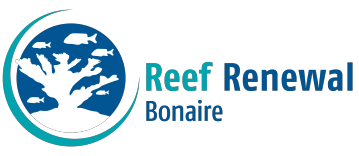Coral spawning is a magical phenomenon that occurs when corals sexually reproduce, which happens every year on reefs around the world. The Caribbean Research and Management of Biodiversity (CARMABI) has published its 2022 coral spawning prediction calendar for Bonaire and the South Caribbean. With this report, our team at the Reef Renewal Foundation Bonaire has taken the time to create a guideline which explains how and why we use it and how you can too.
What is Coral Spawning?
During the summer and early fall months of the Caribbean, it is coral spawning season. Coral spawning is an annual event during which corals simultaneously sexually reproduce by releasing gametes (sperm and eggs) into the water column.
Most broadcast-spawning coral species are hermaphrodites meaning that each polyp of a colony will release a bundle of eggs and sperm. The 1/3 of species left have separate sexes (gonochoric); one colony is female, while another colony is male. In order to synchronize between each other, the colonies of the same species will respond to cues like water temperature, moon cycle and sunset times.
How are the coral spawning predictions calculated, and how do you use it?
Every year, researchers from CARMABI & SECORE release a calendar of the coral spawning predictions for Bonaire and the Southern Carribean islands, for most of the species on our reefs. Spawning dates and times in this calendar are mainly calculated based on the monitoring and observations of the previous years as well as the local moon cycle and sunset time.
What to expect on the Bonaire reefs in the coming months:
- Grooved brain corals that Reef Renewal team and volunteers have been monitoring and collecting spawn from last month will likely spawn again in July and August.
- August is the best month to observe Elkhorn, Staghorn and Pilar coral spawning!
- September and October are months when ‘mass spawning events’ happen. Most coral species will spawn in their own specific window during these months. However, don’t forget to keep an eye out for sponges, invertebrates and gorgonians as well! The reef is buzzing with activity during these nights.
Coral spawning guidelines and tips
While coral spawning is a unique and extraordinary event to witness, good dive practices and common sense are required: watch out for your buoyancy, be aware of your surroundings and of your buddy(s), remember that marine life will always have priority over a good picture.
Tips for a better coral spawning experience:
- Make multiple dives on multiple nights – spawning is a natural event and is never assured (particularly in a changing climate)
- Dive at a site where coral cover is dense
- Don’t miss the window! Get in the water before spawning time
- Dive in the shallows, the reef is just as beautiful, and you will be able to stay longer
- Use a dimmer dive light – corals are photosensitive animals!
- Look above the reef and scan the water column for clouds of spawn
Your observations can help coral conservation and research! We encourage you to share your data and observations (species, date, time, location, and pictures if possible) with us if you jump in the water at one of the numerous dive sites around Bonaire.
How do we use coral spawning for coral reef restoration?
Coral spawning season is also the time at which our larval propagation project takes place. Larval propagation (or assisted coral reproduction) is a coral reef restoration method used alongside fragment propagation on Bonaire and in other parts of the world to restore coral reefs.
For targeted coral species, our team collects the gamete bundles that will be brought back to shore where we assist the fertilization of the reproductive cells. Embryos will develop into swimming larvae that will settle on seeding units sheltered in our in-situ nursery (CRIB – Coral Rearing In situ Basin). Once their development is finished, the seeding units will be outplanted to the reef where the coral juveniles will continue growing.
 This BEST 2.0+ project has received
This BEST 2.0+ project has received
funding from the European Union.








Hello,
I’m planning an upcoming dive trip to Bonaire and hope to experience some coral spawning. It looks like July, August and September are the months during which spawning is most likely to occur. I see your information above on which types of corals are likely to spawn at certain times. Would SECOR and CARMABI have even more accurate predictions? I checked CARMABI’s website and didn’t see a chart out yet for 2024.
I’m also going to let you know when I’ll visit so you can book me on two or three coral outplanting dives, now that I have PADI Coral Restoration Diver specialty certification.